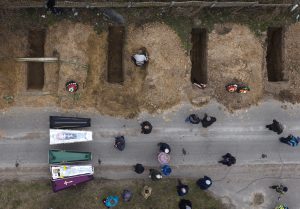“Have the Russians lost it completely?” asked Arnab Goswami, host of a popular news show on Republic TV. Most nights, “the Tucker Carlson of India” sticks to a hyper-nationalist script in line with the government’s policies. But in the aftermath of the Bucha massacre in Ukraine, the controversial host pressed the pause button on Russia-friendly coverage. “No, Russians, it’s not fake news,” he said, referring to Foreign Minister Sergei Lavrov’s claim that the killings were staged. “If you’re hearing anything to the contrary, THAT, Russians, is fake news!”
Theatrics aside, Republic TV was not the only English-language station to signal a shift in tone. As graphic reports of bodies lying on the streets of the Kyiv suburb of Bucha began airing in early April, some of India’s leading anchors and correspondents turned sharply critical of Russia. “There has been overwhelming evidence … of war crimes,” said Vishnu Som, an NDTV anchor reporting from the site of a mass grave in Bucha. WION’s Palki Sharma admitted: “It is hard to argue with these pictures … a barbaric retreat by the Russian army.”
The sudden turnaround surprised South Asia watchers. Tanvi Madan, director of the India Project at the Brookings Institution in Washington D.C., marveled at how “one of the loudest talking heads” went from “hosting Russian commentators who were propounding … biowarfare disinformation to actually criticizing Russia for the Bucha massacre, calling it genocide.” One possible explanation: “You’ve seen on Indian TV night after night coverage of what Russian military forces have been doing … it’s not western media coverage.”
Despite the pivot, nationalism infuses public commentary on the war. And the Western world “lecturing” India on Ukraine was still the preferred target of media outrage. “Anything that is critical of the Indian government and its foreign policy gets pushback,” explained Manoj Kewalramani, chair of the Indo-Pacific Research Programme at the Takshashila Institution, a Bangalore-based think tank.
Since late February, when the Indian government evacuated planeloads of medical students from Ukraine, TV news has blanketed the airwaves with scoops and exclusives from the warzone. Leading channels sent multiple reporting teams to the region in a race for market share and international acclaim. The coverage also had lighter moments: “hip-hop” journalism, eye-popping graphics, and unintentional comedy. A video of a Times Now anchor yelling “don’t lecture us here in India” at the wrong guest went viral.
In keeping with India’s neutral stance on the invasion, some channels made it a point to highlight Russia’s side of the story. In early March, WION ran a show titled “Did NATO push Ukraine into war?” They also aired a controversial speech by Lavrov in which the foreign minister claimed Russia had not attacked Ukraine. YouTube temporarily blocked the channel for violating community guidelines. WION accused the video-sharing platform of selective censorship: “Silencing Russia will not end this war.”
Meanwhile, the Russian government offered some Indian journalists unprecedented access to the frontlines in eastern Ukraine. On April 4, an India Today correspondent reported from a Russian tank as it prepared to roll into Donetsk. A few days later, she was in the trenches with the Russian Army during an active gun battle. But the channel’s most explosive story that week came from their Kyiv-based team. Driving into Bucha “minutes after the Russian withdrawal,” India Today anchor Gaurav Sawant witnessed what Russia did not want the world to see: civilians massacred by a retreating army.
When the report aired, headlines played up both sides of the story: “Will the truth of Bucha ever be known?” followed by “Satellite images counter Russian claims” and finally, “Why wasn’t massacre reported on March 19?” The last caption referred to the date of the satellite images showing bodies on Yablonska Street in Bucha. The wording echoed unsubstantiated comments by Russian officials that the mayor of Bucha had not reported the killings until after the troop withdrawal. However, Anatoliy Fedoruk had talked about bodies piling up on the streets as early as March 7. The mayor told the Associated Press that the city could not bury the victims due to the ongoing shelling. “It’s a nightmare,” he added.
Russia’s official position on Bucha did not change despite mounting evidence of war crimes. On April 19, Lavrov gave India Today a headline-making interview. He announced that the military operation was entering a new phase. Lavrov also doubled down on his assertion that the massacre in Bucha was a “fake situation.”
By then, Indian journalists had already documented what they had seen on Yablonska Street and beyond. TV hosts who shape public opinion could hardly ignore the evidence presented by their colleagues. At the end of an interview with Ukrainian President Volodymyr Zelenskyy on April 7, Republic TV host Goswami declared: “The world will change after this … we stand with the people of Ukraine.”

































